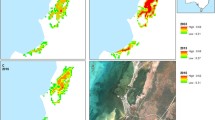Abstract
Based on a field observation at the Vinh Quang coast in northern Vietnam, the characteristics of wave reduction due to the drag force of one mangrove species, Sonneratia sp., were quantitatively analyzed. The reduction rate of sea waves in this area changed substantially with the tidal phase, due to the unique vertical configuration of Sonneratia sp. At the shallow range of water depth, since the shape of pneumatophores of Sonneratia sp. tapers off upward, the effect of drag force by these roots on the wave reduction decreased with the increase in the water level, resulting in a decrease in the rate of wave reduction. On the other hand, when water levels rose above the height of thickly spread branches and leaves of these trees, the rate of wave reduction increased again with an increase in the water level. Further, at this high range of water level, the rate of wave reduction depended strongly on the incident wave height. These results indicate that the thickly grown mangrove leaves effectively dissipate huge wave energy which occurs during storms such as typhoons, and protect coastal areas. Referring to the past studies, our results suggest that the hydrodynamic knowledge in various mangrove conditions such as the vertical configuration of mangrove species, their vegetation conditions, water depth, incident wave condition and the relationships between these factors should be further accumulated and then quantitatively formulated in order to protect coastal areas from severe sea waves.
Similar content being viewed by others
References
C.L. Bretschneider R.O. Reid (1954) ArticleTitleModification of wave-height due to bottom friction, percolation and refraction B.E.B. Tech. Memo 45 1–36
Danielsen F., Sorensen M.K., Olwig M.F., Selvam V., Parish F., Burgess N., Hiraishi T., Karunagaran V.M., Rasmussen M.S., Hansen L.B., Quarto A. and Suryadiputra N. 2005. Asian Tsunami: A Protective Role for Coastal Vegetation. Science 310: 643.
Sundstrom A. and Emma S. 2004. The impact of typhoons on the Vietnamese Coastline. Master of Science Thesis. Coastal Engineering Minor Field Study, 43pp.
M.S. Fonseca J.A. Cahalan (1992) ArticleTitleA preliminary evaluation of wave attenuation by four species of seagrass Estuar. Coast. Shelf Sci. 35 565–576 Occurrence Handle10.1016/S0272-7714(05)80039-3
L. Hamzah K. Harada F. Imamura (1999) ArticleTitleExperimental and numerical study on the effect of mangrove to reduce tsunami Tohoku J. Nat. Disaster Sci. 35 127–132
K. Harada T. Aburaya L. Hamzah F. Imamura (2000) ArticleTitleDiscussion about the effect of tide protecting forests to reduce tsunami Proc. Coast. Eng. Jpn. 47 366–370
J.B. Herbich (2000) Handbook of Coastal Engineering McGraw-Hill New York
Hong P.N. and San H.T. 1993. Mangrove of Vietnam. IUCN, 173pp.
P.N. Hong (2004) Mangrove Ecosystem in the Red River Coastal Zone Agricultural Publishing House Hanoi 509pp
Y. Iwagaki T. Kakinuma (1967) ArticleTitleOn the bottom friction off five Japanese coasts Coast. Eng. Jpn. 10 13–22
Knutson P.L. 1988. Role of coastal marshes in energy dissipation and shore protection. In: Hook D.D. (eds.) The Ecology and Management of Wetlands, 1: Ecology of Wetlands. Timber Press, Portlandpp. 161–174.
Lewis R.R. 2000. Restoration of Mangrove Habitat. ERDC TN-WRP-VN-RS-3.2, http://www.wes.army.mil/el/wrtc/wrp/tnotes/vnrs3–2.pdf, 7pp.
Magi M., Mazda Y., Ikeda Y. and Kurokawa T. 1996. Wave reduction in a mangrove area near the mouth of Shiira River on the Iriomote IslandJapan. Mangrove Sci. 1: 35–42. (in Japanese with English abstract).
S.R. Massel K. Furukawa R.M. Brinkman (1999) ArticleTitleSurface wave propagation in mangrove forests Fluid Dyn. Res. 24 219–249 Occurrence Handle10.1016/S0169-5983(98)00024-0
Y. Mazda M. Magi M. Kogo P.N. Hong (1997a) ArticleTitleMangroves as a coastal protection from waves in the Tong King deltaVietnam Mangroves Salt Marshes 1 127–135 Occurrence Handle10.1023/A:1009928003700
Y. Mazda E. Wolanski B. King A. Sase D. Ohtsuka M. Magi (1997b) ArticleTitleDrag force due to vegetation in mangrove swamps Mangroves Salt Marshes 1 193–199 Occurrence Handle10.1023/A:1009949411068
Y. Mazda D. Kobashi S. Okada (2005) ArticleTitleTidal scale hydrodynamics within mangrove swamps Wetlands Ecol. Manage. 13 647–655 Occurrence Handle10.1007/s11273-005-0613-4
Schiereck G.J. 2004. Introduction to BedBank and Shore Protection. Spon Press, London, 399.
Wolanski E., Mazda Y., Furukawa K., Ridd P., Kitheka J., Spagnol S. and Stieglitz T. 2001. Water circulation in mangroves, and its implications for biodiversity. In: Wolanski E. (eds.) Oceanographic Processes of Coral Reefs. CRC Press, London, pp. 53–76.
E. Wolanski D. Williams S. Spagnol H. Chanson (2002) ArticleTitleUndular tidal bore dynamics in the Daly Estuary, northen Australia Estuar. Coast. Shelf Sci. 60 629–636 Occurrence Handle10.1016/j.ecss.2004.03.001
Author information
Authors and Affiliations
Corresponding author
Rights and permissions
About this article
Cite this article
Mazda, Y., Magi, M., Ikeda, Y. et al. Wave reduction in a mangrove forest dominated by Sonneratia sp.. Wetlands Ecol Manage 14, 365–378 (2006). https://doi.org/10.1007/s11273-005-5388-0
Received:
Accepted:
Issue Date:
DOI: https://doi.org/10.1007/s11273-005-5388-0




